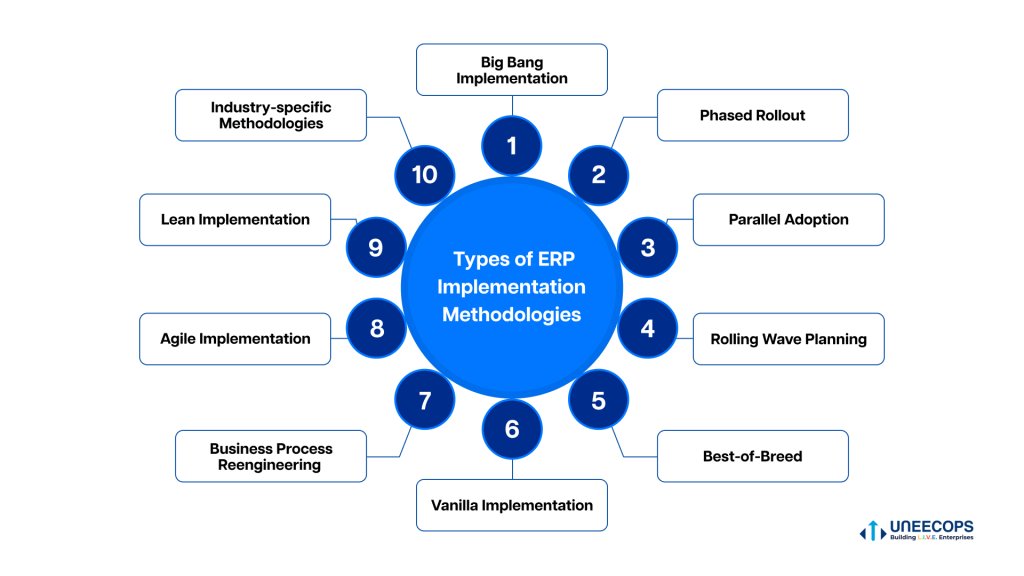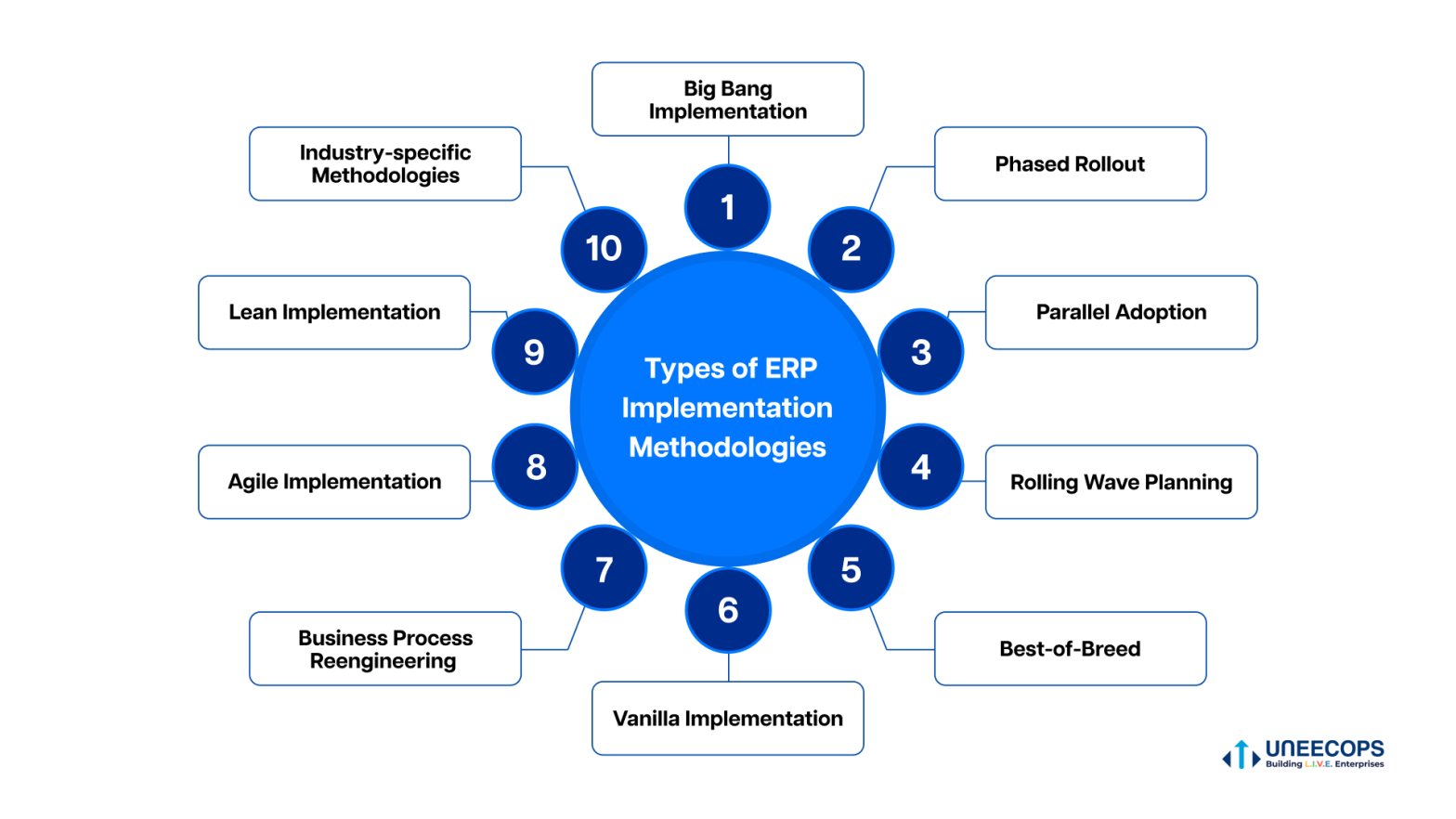Nearly every business that has implemented an ERP system expects magical benefits will fall into place instantly. They expect this enterprise-ready software will drastically transform their business functions such as sales, procurement, production, supply chain and other vital functions. Without any doubt, SAP Business One is a time-tested ERP with its own set of benefits but you need to implement it strategically and give some time to see tangible benefits happening.
Companies can hold these issues liable for their ERP implementation methodology failure.
- No detailed plan or vision, agreement or SLAs defined
- No initiator as to lead the project from beginning to end
- Management is not convinced of implementing ERP and its benefits
- ERP is conceived as an expensive investment
- Companies have carried out implementation owing to peer pressure
Get on the road to success with the apt ERP implementation methodology
It is imperative to contemplate and crystalize the benefits you intend to achieve with SAP Business One. You should state your business aim clearly to the ERP software partner. This will keep them engaged and in focus, which includes framing a timeline and appointing the respective team members to meet the said targets and expectations.
Additionally, getting to the road to success also includes these phases of ERP implementation:
The ERP implementation process comprises all the steps that a business and ERP partner need to take together to ensure successful implementation. The phases of ERP implementation are outlined below in a nutshell:
- Blueprinting and road mapping – Planning is the keyword to get all things right. The same goes for ERP. Before jumping to implementation, ascertaining the organizational goals and analyzing requirements and niche specifications is vital. Then, mapping the requirements to the ERP software’s various modules happens. The company and ERP partner can both assign dedicated teams for the project, depending on the complexity and needs.
- ERP selection: After a plan is in place and everything is mapped out, this stage is all about reviewing competitor ERPs, their USPs and opting for best ERP software in India for the business. This stage also includes discussions on ERP customization, ERP integration and ERP migration.
- Data migration: Once you select the ERP you want to deploy, begin integrating the ERP system with your legacy systems. This involves transferring data to the new system, keeping data security and privacy in mind.
- Testing: Once the new ERP system is implemented and all the phases of ERP implementation are completed, you need to quality assess the software and take measures to correct any discrepancies.
- Go-live: All set? All ERP implementation methodology in place? Now, it is time for company-wide implementation and announcement!
- Training: Comprehensive training for staff is important to embed the new system into the organization’s fabric.
- Post-implementation support: The ERP implementation methodology also involves the post-support stage. In this step, the ERP partner proactively monitors ERP performance and aligns it with business growth. They deliver prompt and effective user support, along with continuously gathering and implementing user feedback for seamless operations.
Types of ERP Implementation Methodologies
ERP implementation methodologies are designed to cater to different industries’ unique needs and requirements. Here are several approaches:
Big Bang Implementation
This methodology, also known as Comprehensive Rollout, involves deploying the entire ERP system in a single rollout. It requires meticulous planning, analysis, and research to avoid business disruptions, financial losses, and missed opportunities.
Phased Rollout
This approach involves gradually implementing the ERP system, often department by department. This allows employees to adapt to the new system over time, reducing resistance and easing the transition.
Parallel Adoption
In Parallel Adoption, the new ERP system is implemented alongside existing legacy systems. This provides a safety net, allowing the legacy systems to continue operating if issues arise during the ERP implementation.
Rolling Wave Planning
Rolling Wave Planning combines methodologies using an iterative approach. Some modules are implemented using the Big Bang approach, while others follow a Phased Rollout.
Best-of-Breed
Also known as Selective Adoption, this methodology involves implementing only the most useful ERP modules rather than deploying the entire system company-wide.
Vanilla Implementation
This approach minimizes implementation time and costs using the default configurations and settings provided by the ERP vendor, with minimal customization.
Business Process Reengineering
This methodology involves redesigning and optimizing existing business processes to align with the new ERP system. It is often used in conjunction with other implementation methodologies.
Agile Implementation
The Agile methodology emphasizes continuous stakeholder collaboration and is preferred for flexibility and adaptability.
Lean Implementation
Lean Implementation eliminates unnecessary steps in the ERP implementation process, reducing waste and maximizing efficiency.
Industry-specific Methodologies
Companies in different industries may use tailored methodologies to meet their specific needs. For example, a food production company will likely use a different approach than a healthcare provider.
Waterfall Methodology
The traditional Waterfall approach follows a linear progression through distinct steps: Discovery, Planning, Design, Development, Testing, Go-live/Deployment, and Support/Maintenance. It is best suited for static environments with well-defined requirements.

How do I know which ERP implementation process is the right one?
Opting for the appropriate ERP implementation process depends on your company’s unique characteristics. Each approach has advantages and disadvantages. For instance, the Waterfall methodology’s linear structure is easy to understand and ideal for stable environments, while the Agile methodology offers greater flexibility for dynamic conditions. Consulting with ERP implementation experts can help determine the best approach for your specific situation.
Always remember this:
- Include all the key stakeholders – in all ERP implementation steps – to make your project succeed
- Illustrate the benefits to key executives and department heads respectively. Obtain their key points and ensure their existing pain points are well addressed with SAP Business One
- Conduct deep research while scouting an SAP Business One partner. Browse his website, social media profiles, watch case studies, inquire about their ERP implementation methodology and so on.
- Make sure you include a baseline idea of project costs so that you can state the same to the management team and expected savings and ROI from the ERP implementation.
With that settled, move on to the next vital ERP implementation steps and ensure the best outcome.
Your key ERP implementation steps should include:
- Identify the vital functions and key features your ERP will have—which specific functionality or add-ons this ERP should have.
- Ascertain whether you will upgrade your existing ERP, migrate it or implement a new one altogether?
- Know what you want to achieve. For instance, bills of materials counting. You should aim to see that functionality or add-on in your ERP.
Know More: ERP Life Cycle and Phases of Successful ERP implementation
In between the road to success, there may be two probable bottlenecks to successful ERP implementation.
One issue that you can witness when you implement ERP is cultural change. Many people in the organization will question why they need to do things differently now. With a strong conviction about this amazing ERP, you should be able to manage those requests and convince them of its benefits.
Another genuine concern, which is an advantage to any business, is that ERP centralizes everything. With ERP in place, all work processes have been automated. As a result, there is no need to perform manual and herculean tasks. Employees’ time is saved considerably, and they need not have to perform repetitive and error-prone tasks. The key message here is that the advanced ERP can replace the functions or even jobs of some local staff, which are now well executed and carried out by the next-gen ERP.
The Conclusion
ERP, such as SAP Business One or any other ERP, is not a magic wand. You need to give it some time and implement it the right way to see the lasting benefits of this amazing ERP. Companies that have implemented new ERP systems or have already installed ERP are reaping great business benefits sooner or later. The key is to employ the right ERP implementation process and engage the right ERP software partner like Uneecops that can guarantee project success. Uneecops is India’s top SAP Platinum Partner and has been awarded the “Partner of the Year – APJ” for 7 years in a row for driving its exceptional customer success. Let us plan all the phases of ERP implementation for you!







